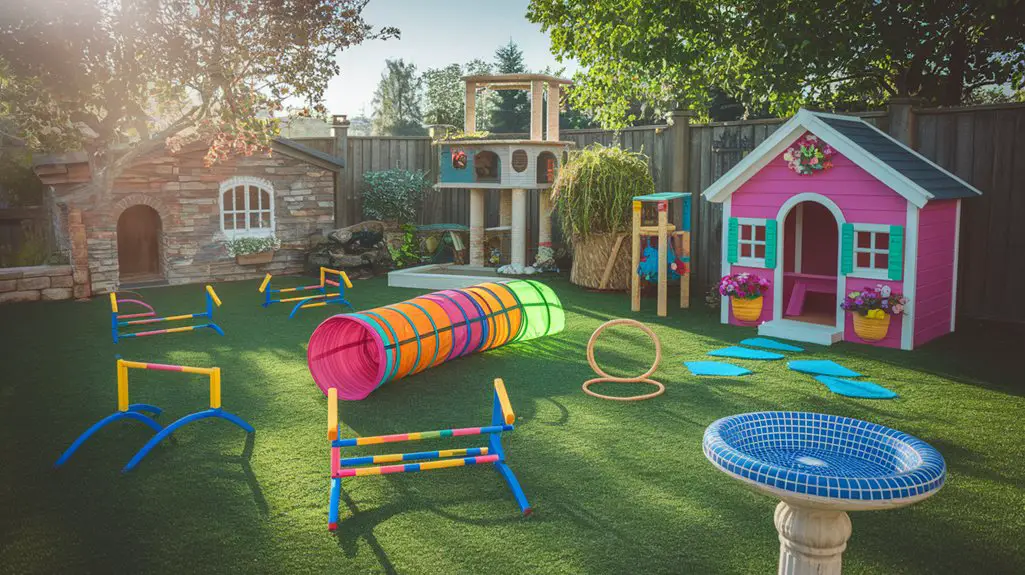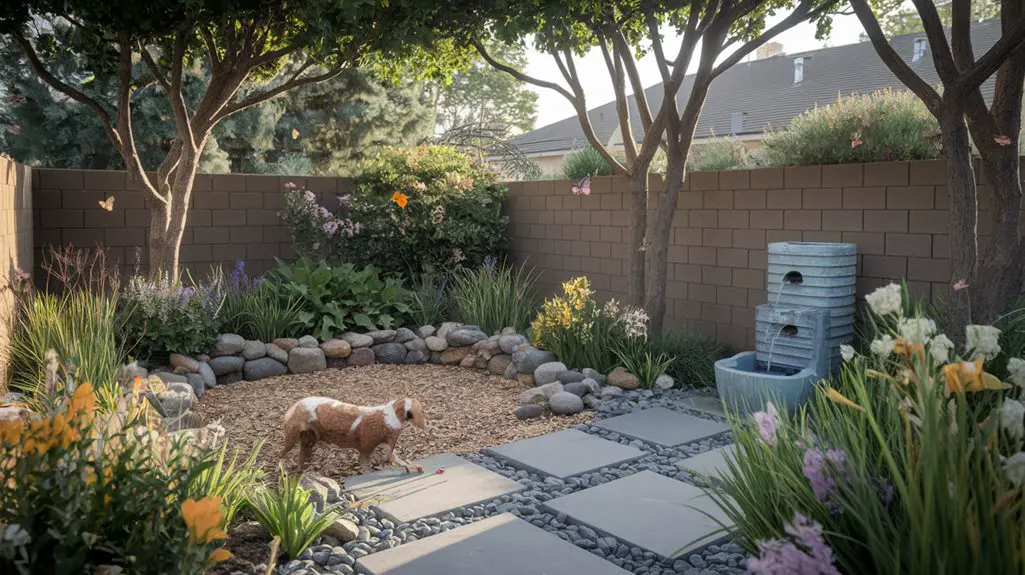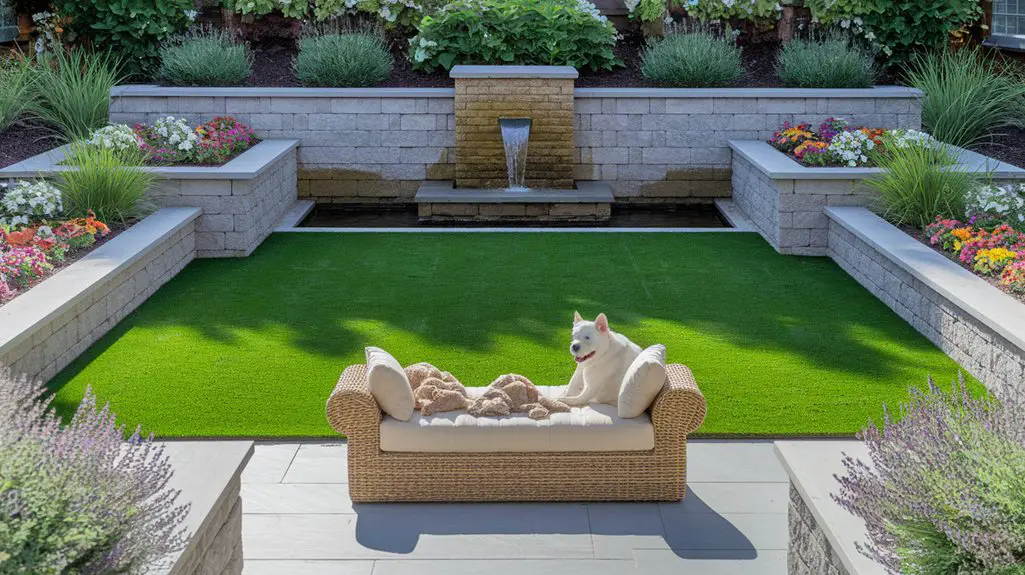Nearly 70% of American households include a pet, making backyard pet-friendly spaces more important than ever. Your furry companions deserve a stimulating outdoor environment that meets their unique needs while keeping them safe. You can transform your yard into a pet paradise with simple DIY projects that encourage exercise, provide comfort, and prevent destructive behaviors. These creative solutions won’t just enhance your pet’s quality of life—they’ll strengthen your bond while making the most of your outdoor space.
Easy-to-Build Dog Obstacle Courses
Creating a backyard obstacle course for your dog combines physical exercise with mental stimulation—two essential components of canine health.
Start with PVC pipes to construct jumps at appropriate heights for your dog’s size and ability. Secure them with T-connectors that allow for height adjustments as your pet progresses.
Add weave poles by inserting garden stakes or dowels into the ground in a straight line, spaced about 20 inches apart.
For tunnels, repurpose children’s play tunnels or create your own using landscaping fabric stretched over wire hoops.
Consider your dog’s age, breed, and physical condition when designing your course. Incorporating multiple pets into the design can enhance the fun and provide social interaction.
Begin with just 2-3 obstacles, gradually adding more as your dog masters each component.
Always supervise training sessions and reward success with healthy treats.
DIY Pet-Safe Water Features
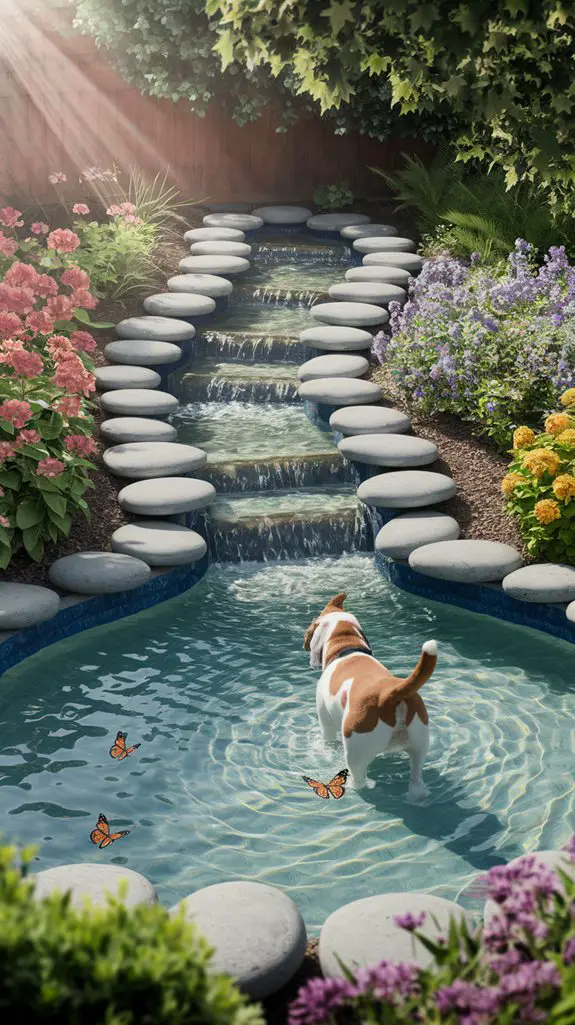
While conventional water features can pose drowning risks for smaller pets, DIY pet-safe water fountains provide invigorating hydration options that minimize hazards.
You’ll want to create gently flowing water sources with shallow basins no deeper than 2 inches for small pets.
Consider a tiered fountain system using food-grade plastic containers, which allows water to cascade between levels. Install a submersible pump with an adjustable flow rate to control water movement.
Always choose non-toxic materials—avoid treated lumber and toxic sealants that could contaminate the water.
For birds, butterflies, and smaller mammals, a shallow pebble bath provides safe drinking access.
Position your water feature in partial shade to prevent algae overgrowth and maintain water quality.
Remember to change the water frequently to prevent mosquito breeding and bacterial growth. Additionally, incorporating a blissful sensory garden can enhance the overall experience for your pets as they explore and interact with nature.
Creating Shaded Relaxation Zones for Pets
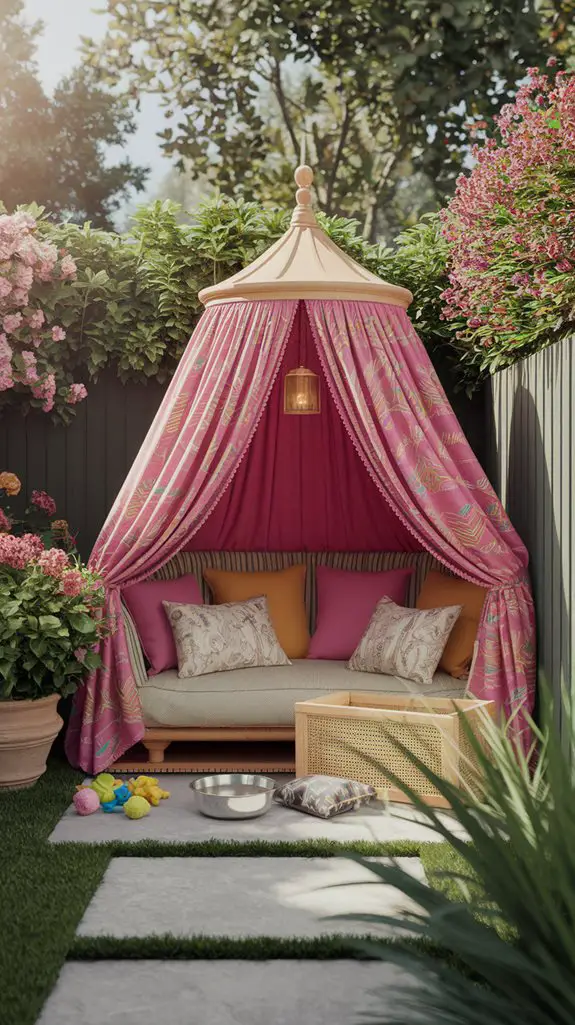
Just as pets need proper hydration, they also require comfortable spaces to rest and escape the sun’s intensity.
Consider building a simple DIY pet cabana using PVC pipes covered with UV-resistant fabric. It’s lightweight, inexpensive, and can be moved around your yard to follow shade patterns.
For dogs who love to dig, create a designated cooling pit filled with moist sand in a naturally shaded area. This provides both comfort and enrichment.
Alternatively, repurpose an old end table into an elevated pet bed by removing the bottom shelf and adding a cooling mat.
Don’t overlook natural solutions—strategically planting pet-safe shrubs can create living shade zones. Additionally, incorporating low-maintenance pet-friendly yard solutions can enhance the overall comfort and enjoyment of your outdoor space.
Whatever design you choose, guarantee there’s proper ventilation and that materials won’t overheat in direct sunlight.
Homemade Outdoor Pet Toys From Recycled Materials
Sustainable pet entertainment doesn’t require expensive store-bought toys when your recycling bin contains perfect raw materials.
Transform empty plastic bottles into durable fetch toys by removing labels and caps, then reinforcing with rope threaded through strategically cut holes.
Old tennis balls gain new life when repurposed into tug toys. Simply cut small slits and thread sturdy rope through them, knotting between each ball.
For canine cognitive stimulation, create treat puzzles from cardboard tubes—fold one end, insert treats, and fold the other end.
For feline friends, craft a dangling chase toy using discarded plastic rings attached to a tree branch with twine.
Before introducing any recycled toy, ascertain you’ve removed hazardous components like bottle caps and thoroughly cleaned all materials to prevent bacterial growth.
Additionally, consider incorporating backyard features for pets that enhance playtime and safety while using these DIY toys.
Building the Perfect Outdoor Cat Playground
Creating an outdoor playground provides your feline companions with essential environmental enrichment while keeping them safely contained in your yard.
Start with secure vertical elements like cedar posts connected by platforms at varying heights. Cats love to climb, so incorporate sisal-wrapped poles and sturdy branches.
Add sheltered areas where your cats can retreat from weather extremes. A small wooden A-frame or repurposed plastic bin with an entrance hole offers perfect protection.
Install sandbox areas for natural digging behavior.
To complete the playground, include sensory elements like cat-safe plants (wheatgrass, catnip, silver vine) and textured surfaces for scratching. Incorporating features like pet-friendly outdoor entertaining can enhance the fun for both your pets and guests.
Always avoid toxic materials and plants. Guarantee all structures are firmly anchored and regularly inspect for stability, especially after severe weather conditions.
Dig-Friendly Designated Zones for Dogs
Many dogs instinctively love to dig, so establishing a designated digging zone in your yard provides them with an appropriate outlet for this natural behavior while preserving your garden beds and landscaping.
Create your dog’s dig zone in a partially shaded area using a child’s sandbox or by marking off a section with wooden borders. Fill it with a mixture of sand and soil that’s easy for paws to manipulate. Bury toys or treats occasionally to encourage appropriate digging behavior.
Keep the area fresh by replacing soil periodically and removing any waste promptly. This dedicated space not only satisfies your dog’s natural urges but also reduces their stress and provides physical exercise, making it a win-win solution for both your yard and your canine companion. Additionally, providing a dig-friendly zone helps to channel their energy in a positive way, preventing unwanted digging elsewhere in your yard.
Pet-Safe Garden Areas With Non-Toxic Plants
When designing outdoor spaces for pets, a pet-safe garden area filled with non-toxic plants should be a top priority for any responsible owner. Toxic plants like lilies, azaleas, and sago palms can cause serious health issues if your furry friend decides to take a curious nibble.
Create designated garden zones using pet-friendly plants that won’t harm your companions.
- Install raised beds to keep curious paws from digging in your prized plantings
- Choose sturdy, non-toxic options like sunflowers, roses, and snapdragons for color
- Plant pet-friendly herbs such as basil, rosemary, and mint for aromatherapy benefits
- Include grasses like wheatgrass or oat grass that cats can safely chew
- Create clear boundaries with decorative pet-safe fencing or stone borders to guide your pet
Additionally, incorporating wildlife-friendly gardening practices can help create a balanced ecosystem that benefits both your pets and local wildlife.
Weather-Resistant Pet Houses and Shelters
Pets deserve a cozy retreat that stands up to the elements, whether they spend most of their time outdoors or just need occasional shelter during backyard play sessions.
You can create durable pet houses using weather-resistant materials like cedar, treated pine, or recycled plastic lumber. Ensure proper insulation by adding foam board to walls and floors, with a vapor barrier to prevent moisture buildup. Elevate the structure at least 4 inches off the ground to protect against flooding and add a sloped roof with overhang to direct rain away. Consider your climate when designing—include cross-ventilation for hot areas or a small, offset entrance with wind barrier in colder regions. Don’t forget to weatherproof with pet-safe sealants and add removable bedding that you can easily wash and replace. Additionally, incorporating pet-friendly landscaping options can enhance the overall comfort and enjoyment of your backyard oasis for your furry friends.
Conclusion
Creating a backyard pet paradise doesn’t require professional skills, just creativity. While many owners focus on indoor comforts, your outdoor space offers unlimited potential for pet enrichment. You’ll find satisfaction in building structures that protect your pets from elements, while simultaneously providing entertainment that stimulates their natural instincts. By balancing safety with fun, you’re investing in both your pet’s physical health and emotional wellbeing—transforming ordinary backyards into extraordinary pet havens.

